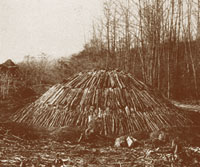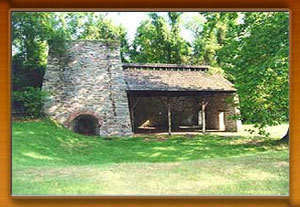TREE TALK
Originally published in Capital on July 17, 2008

Charcoal: History of a Wood Product
How the Iron Industry Changed the Landscape
The first fuel used by early humans for heating and cooking was undoubtedly wood. A couple of hundred thousand years ago propane stoves, heat pumps and gas furnaces were not even on the horizon back then. Food was cooked and people warmed themselves by open fires. And I think it's safe to say, the first humans probably didn't call them campfires; probably because they weren’t camping, they were just there. Whatever their intentions were, wood for fires was a crucial part of human existence, especially in the colder climates. Wood was the most important raw material humans used as it came in readily usable forms that required few if any modifications. Especially wood used for fuel; it's usable as is.
Burning wood has a few drawbacks though, especially for cooking. The smoke gets to be a bit much so, somewhere along the way thousands of years ago, someone discovered the method for making charcoal. Charcoal is made by burning wood under low oxygen conditions. Basically, the wood is piled together, covered with dirt, ignited, and a few days later, voila! Charcoal. By burning under these conditions the moisture and impurities are driven off, and you are left with a lightweight substance that's approximately 90-95% carbon. Charcoal provides an even heat with very little smoke and is still used in many countries today as a primary source of cooking fuel.
Charcoal really became an historically important commodity when the Iron Age began a few thousand years ago. The production of iron was a technological breakthrough that brought humans into the modern era. Wood was integral in developing the process in the form of energy and as a chemical component in the process. Basically, iron is produced by heating iron ore along with charcoal and limestone in a furnace. This is a chemical process in which the iron ore (Fe2O3) is reduced, meaning the oxygen content is removed or reduced, with the carbon from the charcoal reacting with the oxygen from the iron ore to produce carbon dioxide and carbon monoxide and leaving iron in a reduced or pure state. The limestone component acts as a flux binding the impurities together as slag. The charcoal provides the heat and the carbon in this process.
 Iron
production back then demanded a lot of charcoal. As a result forests in Europe
and elsewhere were cut down and converted to charcoal at unsustainable rates.
Europe was almost denuded by the demand for charcoal for use in iron production.
When the British colonies were established, iron production followed shortly
thereafter as iron was expensive to ship. Iron furnaces were located all over
the colonies as the nation started to grow. The first iron furnace in Maryland
was established in Cecil County around 1725, with many more established all over
the state. There is one standing in Cunningham Falls Park in the Catoctin
Mountains that you can visit.
Iron
production back then demanded a lot of charcoal. As a result forests in Europe
and elsewhere were cut down and converted to charcoal at unsustainable rates.
Europe was almost denuded by the demand for charcoal for use in iron production.
When the British colonies were established, iron production followed shortly
thereafter as iron was expensive to ship. Iron furnaces were located all over
the colonies as the nation started to grow. The first iron furnace in Maryland
was established in Cecil County around 1725, with many more established all over
the state. There is one standing in Cunningham Falls Park in the Catoctin
Mountains that you can visit.
The typical iron furnace of those days produced around 3,000 - 4,000 tons of iron per year using around 11,800 - 12,000 cords of wood to do so. Now given that there are about 30 cords of wood on the average acre of forest in this area, that translates into about 400 acres of forest land. Since there were numerous iron furnaces around and many that operated for over 150 years that adds up to a lot wood. It's probably true that much of this land was converted to agriculture afterwards so it was in the 'way' so to speak, and would have been cleared anyway, but it's still a loss.
Coal and eventually coke took the place of charcoal in the iron making process. Coke being very efficient and like coal cheap to produce. Charcoal making on the other hand was very labor intensive and time consuming to boot. This took some of the pressure off the forest, but shifted the resource pressure to mining activity, which was inevitable since the demand for iron and steel required more fuel and carbon than the forest could provide.
Nowadays, charcoal is relegated to uses other than industrial processes. Here in America, charcoal is mostly used for backyard cooking. Gas grills using propane as a fuel have been the rage the last twenty-five years or so, but charcoal purists have persisted and charcoal has made a comeback. Charcoal briquettes are the staple source most folks use when grilling. Briquettes are made from wood residues like bark and sawdust from lumber mills that are mixed with binding agents, pressed into shape and 'roasted' into charcoal. Briquettes are easy to use and light and provide a consistent heating source, although many purists prefer the lump charcoal. Charcoal is still an important part of the forest products industry though, since wood residues from sawmills were formerly wasted, allowing better utilization of the harvested trees.
Charcoal is just another example of the many things the
forest provides us with - the things we need to live, and to make life a bit
easier. Burgers anyone?
Questions and comments can be directed to
ForestGreenway@comcast.net
Bud Reaves writes Tree Talk for the Anne Arundel County Forest Conservancy
District Board.
Photo of Charcoal Kiln and Photo of Johnson's
Furnace,
Courtesy of Maryland
Forest Service Archives
"TREE TALK" Archives
Additional Forestry-Related Links
Champion Trees of Anne Arundel County
Big Tree Champions of Maryland
Native Plants for Anne Arundel County
Planting and Care of Your Trees
TREE-MENDOUS MARYLAND
Invasive Species